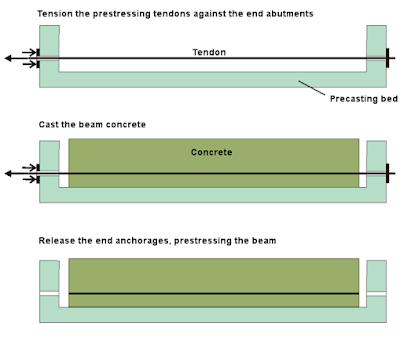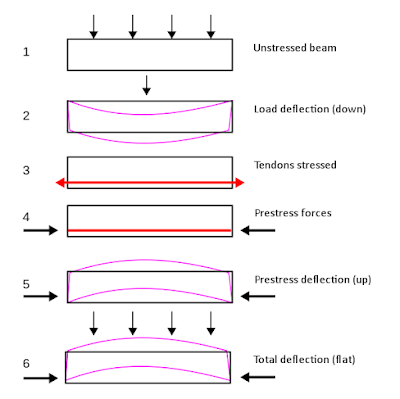Definition of Post Tensioning Concrete
Post-tensioning is a method of reinforcing (strengthening) concrete or other materials with high-strength steel strands or bars, typically referred to as tendons. Post-tensioning is a form of prestressing. Prestressing simply means that the steel is stressed (pulled or tensioned) before the concrete has to support the service loads. Most precast, prestressed concrete is actually pre-tensioned-the steel is pulled before the concrete is poured. Tensioning (or "stressing") of the tendons may be undertaken either before (pre-tensioning) or after (post-tensioning) the concrete itself is cast.
Post-tensioned concrete can use either bonded or unbonded tendons
Tendons may be located either within the concrete volume (internal prestressing), or wholly outside of it (external prestressing). Whereas pre-tensioned concrete by definition uses tendons directly bonded to the concrete, post-tensioned concrete can use either bonded or unbonded tendons. Finally, tensioning systems can be classed as either monostrand systems, where each tendon's strand or wire is stressed individually, or multi-strand systems where all strands or wires in a tendon are stressed simultaneously.Post-tensioned concrete is a variant of prestressed concrete where the tendons are tensioned after the surrounding concrete structure has been cast.

The tendons are not placed in direct contact with the concrete, but are encapsulated within a protective sleeve or duct which is either cast into the concrete structure or placed adjacent to it. At each end of a tendon is an anchorage assembly firmly fixed to the surrounding concrete. Once the concrete has been cast and set, the tendons are tensioned ("stressed") by pulling the tendon ends through the anchorages while pressing against the concrete. The large forces required to tension the tendons result in a significant permanent compression being applied to the concrete once the tendon is "locked-off" at the anchorage.
Method of locking the tendon-ends to the anchorage
The method of locking the tendon-ends to the anchorage is dependent upon the tendon composition, with the most common systems being "button-head" anchoring (for wire tendons), split-wedge anchoring (for strand tendons), and threaded anchoring (for bar tendons). Tendon encapsulation systems are constructed from plastic or galvanised steel materials, and are classified into two main types: those where the tendon element is subsequently bonded to the surrounding concrete by internal grouting of the duct after stressing (bonded post-tensioning); and those where the tendon element is permanently debonded from the surrounding concrete, usually by means of a greased sheath over the tendon strands (unbonded post-tensioning).

Casting the tendon ducts/sleeves into the concrete before any tensioning occurs allows them to be readily "profiled" to any desired shape including incorporating vertical and/or horizontal curvature. When the tendons are tensioned, this profiling results in reaction forces being imparted onto the hardened concrete, and these can be beneficially used to counter any loadings subsequently applied to the structure.





